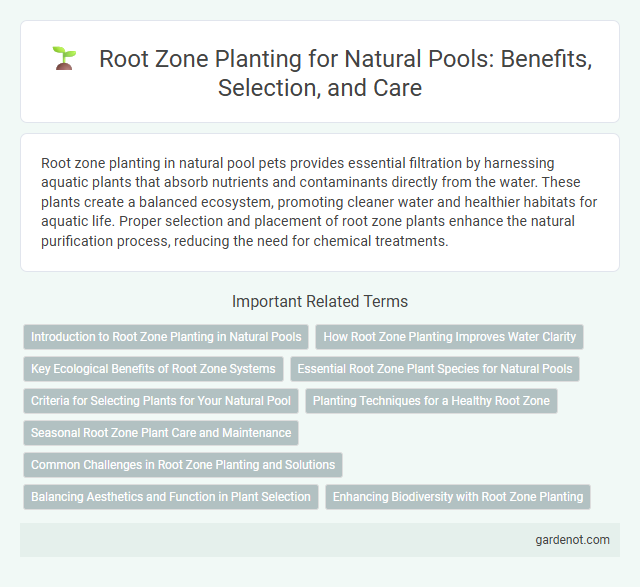Root zone planting in natural pool pets provides essential filtration by harnessing aquatic plants that absorb nutrients and contaminants directly from the water. These plants create a balanced ecosystem, promoting cleaner water and healthier habitats for aquatic life. Proper selection and placement of root zone plants enhance the natural purification process, reducing the need for chemical treatments.
Introduction to Root Zone Planting in Natural Pools
Root zone planting is a vital component of natural pool ecosystems, utilizing specific aquatic plants to filter and purify water through their root systems. These plants, rooted in the biofilter zone, absorb nutrients and contaminants, promoting clear and balanced water chemistry without chemicals. Effective root zone planting enhances biodiversity while maintaining a sustainable, low-maintenance natural swimming environment.
How Root Zone Planting Improves Water Clarity
Root zone planting enhances water clarity in natural pools by facilitating biological filtration through the plant roots, which absorb excess nutrients and contaminants, reducing algae growth. The roots promote beneficial microbial activity that breaks down organic matter, maintaining balanced water chemistry. This natural filtration process leads to clearer and healthier pool water without chemical treatments.
Key Ecological Benefits of Root Zone Systems
Root zone planting in natural pools enhances water purification by utilizing specific aquatic plants to absorb nutrients and filter pollutants, promoting clearer and healthier water ecosystems. These systems support biodiversity by providing habitat for microorganisms and aquatic life, contributing to ecosystem stability and resilience. The root zone also stabilizes sediment and reduces erosion, maintaining water clarity and supporting long-term ecological balance.
Essential Root Zone Plant Species for Natural Pools
Essential root zone plant species for natural pools include cattails (Typha latifolia), water irises (Iris pseudacorus), and pickerelweed (Pontederia cordata). These plants enhance water filtration by absorbing nutrients and providing habitat for beneficial microorganisms. Their extensive root systems stabilize pool substrates, ensuring clear water and a balanced aquatic ecosystem.
Criteria for Selecting Plants for Your Natural Pool
Choosing plants for root zone planting in a natural pool requires selecting species with high pollutant uptake and strong oxygen release to maintain water clarity. Opt for native aquatic plants like Cattails, Sweet Flag, and Water Lilies known for their adaptability and low maintenance. Ensure the plants have robust root systems to stabilize the substrate and support beneficial microorganisms that enhance natural filtration.
Planting Techniques for a Healthy Root Zone
Root zone planting techniques in natural pools emphasize selecting native aquatic and marginal plants with deep root systems to enhance water filtration and nutrient uptake. Proper spacing ensures adequate oxygen flow and prevents root crowding, promoting a resilient, healthy ecosystem. Incorporating biodegradable plant supports stabilizes roots while preventing erosion and encouraging beneficial microbial activity.
Seasonal Root Zone Plant Care and Maintenance
Seasonal root zone plant care in natural pools involves monitoring soil moisture levels and adjusting irrigation to prevent water stress during dry periods. Regular pruning of root zone plants promotes healthy growth and enhances natural filtration by removing dead or decaying material that can affect water quality. Fertilization using low-nutrient inputs supports plant vitality while avoiding excess nutrients that could disrupt the pool's ecological balance.
Common Challenges in Root Zone Planting and Solutions
Common challenges in root zone planting of natural pools include soil erosion, nutrient imbalances, and invasive plant species spreading. To address soil erosion, using deep-rooted native plants stabilizes the sediment, while regular monitoring and selective harvesting help maintain nutrient balance. Implementing a diverse planting scheme with native species controls invasive plants, ensuring a healthy and sustainable root zone environment.
Balancing Aesthetics and Function in Plant Selection
Root zone planting in natural pools emphasizes selecting plant species that enhance water purification while complementing the pool's visual appeal. Choosing a diverse mix of aquatic plants with strong root systems, such as water lilies, cattails, and iris, maximizes nutrient uptake and sediment stabilization. This careful balance of aesthetics and function ensures a healthy ecosystem and a visually pleasing natural pool environment.
Enhancing Biodiversity with Root Zone Planting
Root zone planting in natural pools significantly enhances biodiversity by creating a habitat rich in native aquatic plants that support diverse microorganisms and aquatic species. These plants filter water naturally, improving water quality while providing shelter and food for insects, amphibians, and fish, fostering a balanced ecosystem. Incorporating a variety of species in the root zone maximizes ecological resilience and promotes sustainable aquatic life.
Root zone planting Infographic

 gardenot.com
gardenot.com